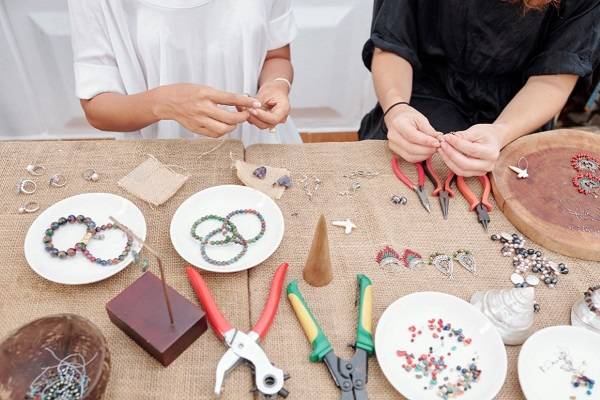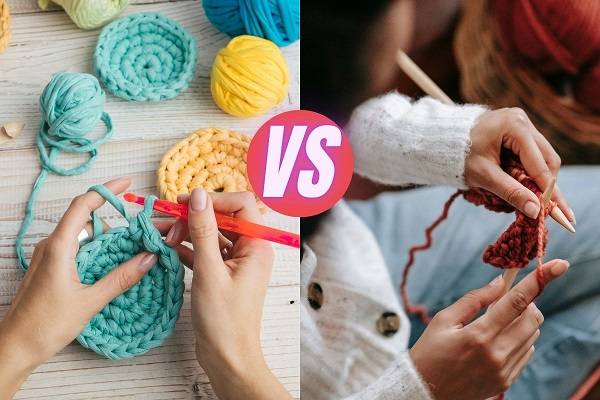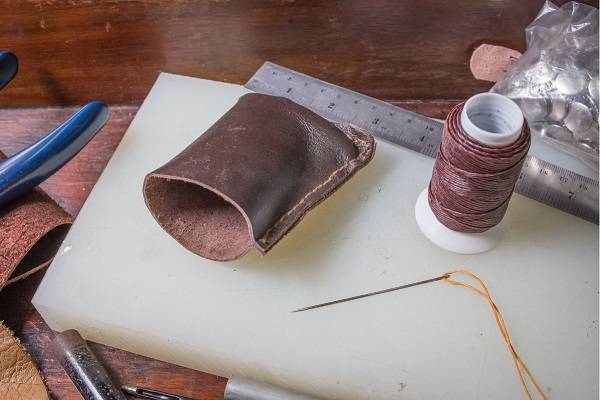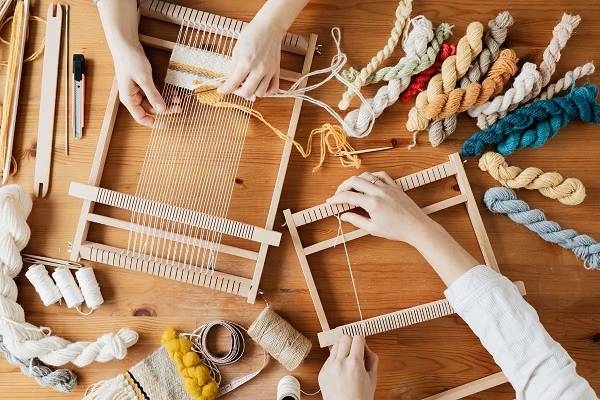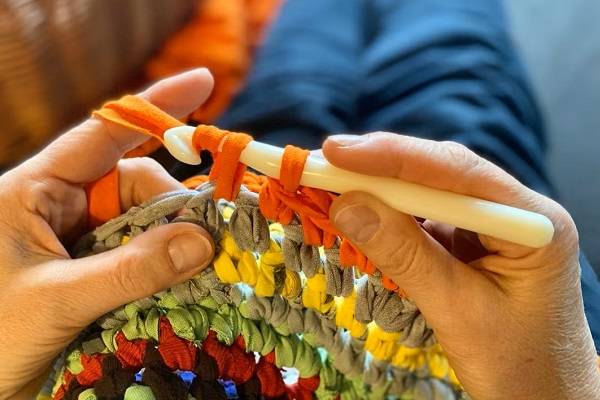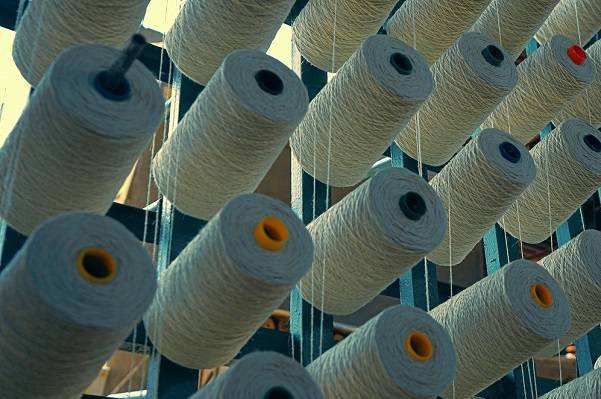EMBROIDERY 101
How to Start Embroidery: Quick Guide For Beginners
Master The Basics of Needlework: Simple Techniques, Easy to Learn Stitches, Design Ideas, Tools & Supplies.

Innovation & Quality
Developing and supplying premium-quality, sustainably grown, consumer products
100% Natural
Organically Grown and Ethically Sourced
hemp and other natural fiber products
Shipping
We offer fast shipping
Your order out within 1-3 days
Wholesale
Visit our wholesale portal to register or login to your account
Hand embroidery is a cost-friendly craft that allows you to express your creativity and make beautiful embellishments on fabric using only a thread and a needle. It’s quite enjoyable and pretty easy to learn. By mastering a few elementary stitches and basic techniques you will be able to make your first embroidery in a relatively short time. With a little practice, you'll get the hang of it in no time. Plus, needlework is a nice calming activity that helps you unwind after a busy day at work.
Table of Contents
Premium Sewing Threads For Retail & Wholesale Customers
Hemptique is global name in manufacturing innovative, eco-friendly and sustainable craft supplies. Our mission is to offer top-quality merchandise which will empower hobbyists, artists, and entrepreneurs around the world to turn their ideas, inspirations and creativity into reality. Our product line includes premium cordage renowned for its quality, strength, durability, ease of handling, and color retention properties. Visit our web shop to find out more about our bestselling sewing threads - #10 (0.5mm) Hemp cord spool, Premium linen thread (0.6mm) made of 100% flax fiber, non-fraying Premium linen cord 0.5mm, 1mm Organic cotton bakers twine, and 0.8mm Braided & flat waxed thread. We work with individual consumers and retail businesses nationwide and internationally. If you want to find out more about our products, give us a call at (760) 602-4864 ext. 403 & 406. You can also apply for a wholesale account, or send a bulk order request.
What Is Embroidery
Embroidery is an ancient art of ornamental decorating of fabrics or other materials (leather, canvas) by using a needle and thread. Decorative, colorful stitching is used to create simple or intricate designs or patterns on linens, napkins, table runners, Christmas stockings, pouches, t-shirts, caps, etc.
Needlework Through History
Embroidery is a very old craft that developed from sewing, when people started to explore its decorative possibilities. It originates from China and the Near East and some of the earliest fossilized remains of needlework can be traced back to about 30,000 BCE.
Throughout the ages, it was often used to show religious symbolism, personal identity, or social status. Embroidered garments were typically worn by upper classes and wealthy personas. In many religions sacred garments or even sacred books were often decorated with needle and thread. During the Middle Ages, there were many embroidery guilds, and professional and amateur production was flourishing. Often times, the daughters of wealthy families had to practice this skill to show their social standing. Around 1900s it was no longer the pastime of high society, as the materials became cheaper and easily affordable to a wider audience.
Tools & Supplies
As a relatively affordable pastime, hand embroidery hobby requires just a few basic tools and supplies which are easily found in most supply stores. But, although there is a large selection of various materials on the market, it is recommended to purchase items of better quality. They will not only be easier to work with but will also ensure longevity of your handcrafted item.
Embroidery hoop
This tool is used for embroidery and cross stitch. It is usually made of wood or plastic and has two parts – inner ring and outer ring. Its main purpose is to keep the fabric tight, maintaining an even tension, and preventing the textile from creasing and wrinkling while you sew. The hoop comes in a range of sizes, from 3” to 12”. If you are just starting out, choose a 4 to 6 inches hoop. Several kinds of hoops are available on the market – screw tension hoops, spring tension hoops, flexi hoops, Q-snaps, etc. Regardless of which hoop you choose, the fabric should be placed on the inner ring, as tight as possible to ensure the stitches are neat. You could also embroider without a hoop, but it will be significantly more difficult, especially if you are a novice learner.
Embroidery Floss
For needlework, you can either use embroidery floss or regular sewing thread that fits your project’s needs.
- Embroidery floss - 6-stranded cotton floss is most commonly used for stitching due to its distinctive texture and color intensity. It has to be separated before use.
- Regular sewing thread – You can also use any standard sewing threads. Whenever you can, choose good quality fiber, to ensure long shelf-life, better color retention, smooth texture, and to prevent shrinkage and fraying.
Fabric
The easiest fabrics to pierce with needle are natural fibers, such as linen, cotton, felt or hemp. They are sturdy and tight, making them a lot easier to work with than synthetic materials which typically have loose weave. For this reason, beginners like you should opt for 100% linen or 100% cotton ('Quilters' quality cotton). Although any fabric can be used, you should be aware that some textiles are more difficult to stitch on.
Needle
For needlework, it is best to use a needle with larger eye, because it will be easier for you to thread any size of string. Specialty needles for stitching come in various sizes (between 1 and 12) with larger number denoting smaller needle.
You will also need
Other tools you may need include sharp scissors, washable (ease) marker, thimble, seam ripper, etc.

How To Embroider by Hand
To start embroidering, follow these simple steps:
Step 1 - Prepare the fabric
Cut the fabric to the size a bit larger than the design itself, leaving enough room for you to place it in the hoop (1’-2” larger). You can place the fabric on the hoop first, and then cut the perimeter. Before you begin, seal the edges of fabric to prevent fraying. You can either use masking tape or sewing machine for this.
Step 2 - Transfer the template onto the fabric
The easiest way to do this is to trace it with washable or erasable pen or chalk. If it is hard for you to see the design through the fabric, place them onto a sunny window or use lightbox.
Step 3 - Place the fabric into a hoop
Center the design you are stitching and tighten the hoop around it. Pull the fabric tightly as a drum to remove any ridges, wrinkles, and bubbling. You will also have to adjust and retighten as you work.
Step 4 – Prepare the needle and thread
If you are using embroidery floss, measure the necessary length and cut. If needed, untwist and separate the floss. 6 strands give a puffier and fuller look, while less strands are more suitable for more delicate patterns.
Step 5 - Start stitching
Using our guide and other online resources, start stitching and see for yourself how easy it is to create lovely adornments.
Basic Embroidery Stitches For Beginners
As with any other craft or skill, learning how to stitch also takes time. Start by focusing on basic stitches and simple designs first. With just a few of the basic stitches you will be able to craft your first items! To get you started, we have detailed instructions on how to do 4 basic stitches.
Back stitch
Although it uses a lot of thread, back stitch is still one of the favorites ones because it’s simple to make and holds pretty well. It is excellent for securing seams and look neat when consistency in length is maintained. Follow the steps below to make one of the strongest stitches out there.
- Bring the thread up from the back side of the fabric
- Go back down to make a straight stitch
- Come back up in front of where you started, ensuring stitches are even
- Insert the needle into the fabric right where your last stitch ends
Variations: whipped backstitch, Pekinese stitch, split back stitch, open back stitch
TIP: If your design has curved lines, shorten the stitches for a more polished appearance.
TIP: If your design has curved lines, shorten the stitches for a more polished appearance.

Running stitch
Running stitch is considered one of the easiest stitches. It is a great starting point if you want to get into needlework, as it is done by simple and repetitive up and down motion.
- Start from the back. Bring the needle up at the starting point, and then down to make a straight stitch
- Make another stitch, at a distance which is roughly the same length as the first stitch
- Continue making stitches in a straight line, trying to keep them the same size and at same distance to make them look consistent.
Variations: looped running, interlaced running, fairy lights, parallel running, seed stitch
TIP: Use a marked tape or a ruler as a guide to get even running stitches.
TIP: Use a marked tape or a ruler as a guide to get even running stitches.

Satin stitch
Satin stitch is another beginner-friendly embroidery stitch that’s very easy to recreate. This technique creates a smooth fill of the shaped area. It entails sewing straight parallel stitches next to each other so that the complete fabric base is covered. Since it is fairly easy to make, you’ll have it mastered in no time.
Here’s how to do it:
Here’s how to do it:
- Stitch the outlines of the shape using backstitch (or split stitch).
- Insert the needle up through the stitched edges of the shape you need to fill. Ensure you angle the needle a bit so your work looks smooth and polished.
- Push the needle down on the opposite side of the shape to create your first satin stitch.
- Next, bring the needle up again right where your first stitch started.
- Continue sewing in under-and-over motions until you fill the whole shape.
Variations: leaf stitch, brick stitch, padded satin stitch.
TIP: Use fine needle and thicker thread and make sure the stitches are touching each other. This ensures the fabric below can’t be seen. Starting from the center of the shape helps even distribution and high quality work.
TIP: Use fine needle and thicker thread and make sure the stitches are touching each other. This ensures the fabric below can’t be seen. Starting from the center of the shape helps even distribution and high quality work.

Chain stitch
This is one of the prettiest stitches to showcase lettering and bold outlines. It is a wonderful solution for sewing monograms on napkins, handkerchiefs, Christmas stockings, linens, backpacks, and jackets. Start by drawing the initials on fabric and then stitching by following these steps:
- Bring the needle up from the back side of fabric.
- Take the needle back down the same hole you came up through. This will form a loop which you need to catch with your finger. Don’t pull the whole length of the thread back down. Leave loop large enough for you to do another stitch (about 1”).
- In the middle of the loop, a little further along the line, insert the needle back up.
- Pull the thread completely to finish the first stitch.
Variations: Tied chain stitch, interlaced chain stitch, double chain stitch, lazy daisy.
TIP: Your chin stitches will look their best if you can maintain the same length of chains.
TIP: Your chin stitches will look their best if you can maintain the same length of chains.

How To Finish the Hoop
After you have finished sewing, you have to secure the excess fabric on the hoop before it’s ready to be displayed at your home.
- Start by centering the design in the middle of the frame.
The excess fabric should be about 1 to 1.5 inches (cut the extra off)
- Make running stitches all the way around and tie a secure knot in the end.
- Optionally, you can cover exposed stitches with a piece of fabric
The Last Step – Wash & Press/Iron Your Handicraft
When you finish your design, it is time to wash your work, even if you don’t see any stains. During stitching, your hands release natural oils onto the fabric, which cannot be seen at first, but can become stains over time. This is why it’s important to wash your finished project even if it looks clean. Here’s how to do it:
- Soak in warm water and a small amount of gentle detergent for approximately 15 minutes
- Wash and sponge gently so that you don’t damage the stitches, rinse in lukewarm water and leave to air dry on flat surface
- It is best to press (or iron) while the fabric is still slightly damp
- Always place a clean, thin cloth over your item and carefully iron until the fabric is dry.
Mistakes to Avoid as a Beginner in Embroidery
Embroidery is an enjoyable craft, but as with any new skill, beginners can encounter challenges that may affect the outcome of their work. Here are some common mistakes to watch out for and how to avoid them:
Using the Wrong Fabric
Beginners often choose fabrics that are too thin or too stretchy, making it difficult to control stitches. Start with tightly woven fabrics like cotton or linen, which are much easier to work with and hold stitches well.
Not Using an Embroidery Hoop
Skipping the hoop can cause your fabric to bunch up, leading to uneven and messy stitches. Always use an embroidery hoop to keep the fabric taut while stitching for neat and consistent results.
Pulling the Thread Too Tight
Beginners tend to pull the thread too tight, which distorts the fabric and makes the design look uneven. Be sure to keep your tension even, so the fabric lies flat without puckering.
Starting with Complicated Patterns
Jumping into complex designs too soon can be frustrating and overwhelming. Start with simple patterns and basic stitches, then gradually move on to more detailed work as you gain confidence and experience.
Using Too Much Thread
Using long lengths of thread can lead to tangling and knotting. A good rule of thumb is to use about 18 inches (45 cm) of thread at a time to avoid messes and make it easier to control.
Not Separating Embroidery Floss
Embroidery floss usually comes in 6 strands that need to be separated for most projects. Failing to separate them can make your stitches look bulky and uneven. Be sure to separate the strands to fit the design.
Neglecting to Plan the Design
Many beginners jump right into stitching without properly transferring or planning their design. Take the time to trace your pattern onto the fabric using a washable marker or chalk, ensuring accurate placement and a professional finish.
Ignoring Care Instructions
Once your project is finished, improper washing and care can ruin your hard work. Always wash embroidered items gently in cold water and avoid harsh detergents or scrubbing.

Care Instructions For Handmade Embroidery
You are probably aware that all embroidered items require special care. Based on fabric and thread type you chose; you will determine how they need to be washed. It is recommended to hand-wash them, using mild detergent and warm water, or spot cleaning more delicate materials like silk. Avoid scrubbing, using harsh detergents and water that is too hot. Rinse with water and air dry.
- Hand wash, or run on delicate cycle (cold water)
- Rub gently, never scrub
- Do not tumble dry
- Lay flat to dry
Embroidery Ideas: Things You Can Embroider By Hand
If you need inspirations and ideas on what you can embellish with new stitched design, you’ll be happy to know that your possibilities are countless. In fact, any fabric with tight weave can be a place to flaunt your stitching skills.
This craft is exceptionally versatile because you can decorate almost any type of textile:
This craft is exceptionally versatile because you can decorate almost any type of textile:
- Clothing: jeans, aprons, hoodies, shirts, knitwear
- Accessories: handbags, headbands, belts, scarves, shawls, gloves, hats, tote bags
- Home décor items: napkins, towels, pillowcases, placemats, table runners
- Art: framed designs, wall hangings, art pieces on fabric
Modern-Day Applications of Embroidery
Today embroidery is more than a traditional craft. It has evolved into a versatile art form with applications across various industries. Here’s a look at how embroidery is used in modern contexts:
- Fashion Industry: Embroidery is a significant part of haute couture and street fashion. Designers incorporate intricate embroidery into garments, bags, shoes, and accessories to add luxury and personalization. Embroidery patches are also trending, allowing individuals to customize jackets, jeans, or even sneakers.
- Home Décor: Custom embroidery has found a place in interior design, where hand-embroidered pillows, wall hangings, and table linens add a personal touch to homes. It offers a timeless way to enrich spaces with unique designs or monogrammed details.
- Business Branding: Many companies use machine embroidery for custom uniforms, hats, and promotional items. Embroidered logos on clothing or accessories provide a professional look and help in brand building.
- Event Customization: Personalized embroidered gifts for weddings, birthdays, or corporate events are becoming popular. Monogrammed towels, napkins, or even embroidered keepsakes offer a thoughtful and elegant touch to special occasions.
- Art & Craft Shows: Modern crafters often display hand-embroidered art pieces in exhibitions, fairs, or sell them through online platforms like Etsy. These works not only showcase creativity but also celebrate the revival of handmade craftsmanship.
Closing Note
If you are eager to begin with embroidery, there’s just a few things to remember – start with simple, beginner-friendly stitches (running stitch, backstitch), choose suitable supplies (hoop, needle, thread) and don’t forget to practice. The more you practice, the better you become. Most importantly, have fun, don't be afraid to experiment and enjoy your newly created designs.
FAQ
What is the easiest embroidery stitch for beginners?
Running stitch is one of the easiest stitches for beginners. It's a simple up-and-down motion that creates a dashed line on the fabric.
What supplies do I need to start embroidery?
You’ll need an embroidery hoop, needle, embroidery floss or thread, fabric (like linen or cotton), and scissors. Some projects may also require a washable marker for pattern transfer.
Can you embroider on any fabric?
While you can technically embroider on any fabric, beginners should start with tightly woven natural fabrics like cotton or linen because they are easier to work with.
What’s the difference between hand embroidery and machine embroidery?
Hand embroidery allows for more customization and creativity with intricate details, while machine embroidery is faster and more efficient for large-scale projects or repetitive designs.
How do I care for embroidered items?
Handwash embroidered items in mild detergent and cold water. Avoid scrubbing or twisting the fabric to prevent damaging the stitches. Always air dry flat and iron with a cloth over the embroidery.
How long does it take to learn embroidery?
The time to learn embroidery varies depending on the complexity of stitches. Basic stitches can be mastered in a few hours, while more advanced techniques take longer.
Is embroidery a good hobby to start?
Yes! Embroidery is a relaxing and affordable hobby that can be done anywhere. It’s beginner-friendly and a great creative outlet.


